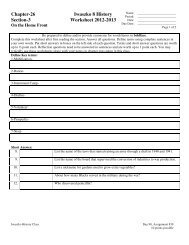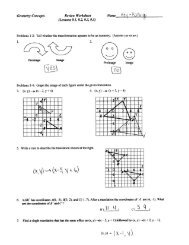Reading Study Guide A - InforMNs
Reading Study Guide A - InforMNs
Reading Study Guide A - InforMNs
Create successful ePaper yourself
Turn your PDF publications into a flip-book with our unique Google optimized e-Paper software.
CHAPTER 1<br />
Introduction to Matter<br />
SECTION<br />
1.3<br />
MATTER COMBINES TO FORM DIFFERENT SUBSTANCES.<br />
<strong>Reading</strong> <strong>Study</strong> <strong>Guide</strong> A<br />
BIG IDEA Everything that has mass and takes up space is matter.<br />
KEY CONCEPT Matter combines to form different substances.<br />
Vocabulary<br />
element a substance with only one type of atom<br />
compound a substance with atoms of more than one type bonded together<br />
mixture a combination of one or more substances that can be separated physically<br />
Review<br />
1. What is all matter made of?<br />
Take Notes<br />
I. Matter can be pure or mixed.<br />
2. Fill in the combination notes for the main idea shown.<br />
MAIN IDEA<br />
DETAIL NOTES<br />
1. Matter can be pure or mixed. A. Often the difference between pure and<br />
mixed substances can only be seen at the<br />
molecular or atomic level.<br />
B. A pure substance has ________________.<br />
C. The components of a pure substance can<br />
be either ____________________________<br />
____________________________________.<br />
D. Mixed substances have ______________.<br />
A. Elements and Compounds<br />
3. Bronze is made by combining the element copper with the element tin. Is<br />
pure bronze an element? Why or why not?<br />
Copyright © by McDougal Littell, a division of Houghton Mifflin Company<br />
34 MATTER AND ENERGY, CHAPTER 1, READING STUDY GUIDE A
4. Fill in the description wheel diagram for compound.<br />
table salt<br />
COMPOUND<br />
water<br />
CHAPTER 1<br />
Introduction to Matter<br />
substance<br />
B. Mixtures and Comparing Mixtures and Compounds<br />
5. Fill in the four-square diagram for mixture.<br />
Definition<br />
Characteristics<br />
Copyright © by McDougal Littell, a division of Houghton Mifflin Company<br />
Examples<br />
MIXTURE<br />
6. Fill in the chart comparing mixtures and compounds.<br />
compound<br />
mixture<br />
Substances That<br />
Make It Up<br />
change to new<br />
substances<br />
Can Be Separated By<br />
physical means<br />
II. Parts of mixtures can be the same or different throughout.<br />
7. What is a heterogeneous mixture? What is a homogeneous mixture?<br />
fixed<br />
Nonexamples<br />
table salt<br />
Proportions<br />
MATTER AND ENERGY, CHAPTER 1, READING STUDY GUIDE A 35
















